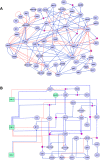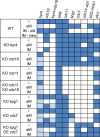An Extended, Boolean Model of the Septation Initiation Network in S.Pombe Provides Insights into Its Regulation
- PMID: 26244885
- PMCID: PMC4526654
- DOI: 10.1371/journal.pone.0134214
An Extended, Boolean Model of the Septation Initiation Network in S.Pombe Provides Insights into Its Regulation
Abstract
Cytokinesis in fission yeast is controlled by the Septation Initiation Network (SIN), a protein kinase signaling network using the spindle pole body as scaffold. In order to describe the qualitative behavior of the system and predict unknown mutant behaviors we decided to adopt a Boolean modeling approach. In this paper, we report the construction of an extended, Boolean model of the SIN, comprising most SIN components and regulators as individual, experimentally testable nodes. The model uses CDK activity levels as control nodes for the simulation of SIN related events in different stages of the cell cycle. The model was optimized using single knock-out experiments of known phenotypic effect as a training set, and was able to correctly predict a double knock-out test set. Moreover, the model has made in silico predictions that have been validated in vivo, providing new insights into the regulation and hierarchical organization of the SIN.
Conflict of interest statement
Figures





Similar articles
-
The septation initiation network controls the assembly of nodes containing Cdr2p for cytokinesis in fission yeast.J Cell Sci. 2015 Feb 1;128(3):441-6. doi: 10.1242/jcs.160077. J Cell Sci. 2015. PMID: 25501814 Free PMC article.
-
Regulation of cytokinesis by spindle-pole bodies.Nat Cell Biol. 2006 Aug;8(8):891-3. doi: 10.1038/ncb1449. Epub 2006 Jul 16. Nat Cell Biol. 2006. PMID: 16845379
-
Modeling the septation initiation network (SIN) in fission yeast cells.Curr Genet. 2007 Apr;51(4):245-55. doi: 10.1007/s00294-007-0123-4. Epub 2007 Mar 6. Curr Genet. 2007. PMID: 17340144
-
Polar opposites: Fine-tuning cytokinesis through SIN asymmetry.Cytoskeleton (Hoboken). 2012 Oct;69(10):686-99. doi: 10.1002/cm.21044. Epub 2012 Jul 11. Cytoskeleton (Hoboken). 2012. PMID: 22786806 Free PMC article. Review.
-
Pombe's thirteen - control of fission yeast cell division by the septation initiation network.J Cell Sci. 2015 Apr 15;128(8):1465-74. doi: 10.1242/jcs.094821. Epub 2015 Feb 17. J Cell Sci. 2015. PMID: 25690009 Review.
Cited by
-
Advances and challenges in logical modeling of cell cycle regulation: perspective for multi-scale, integrative yeast cell models.FEMS Yeast Res. 2017 Jan;17(1):fow103. doi: 10.1093/femsyr/fow103. Epub 2016 Dec 18. FEMS Yeast Res. 2017. PMID: 27993914 Free PMC article. Review.
-
A comprehensive, mechanistically detailed, and executable model of the cell division cycle in Saccharomyces cerevisiae.Nat Commun. 2019 Mar 21;10(1):1308. doi: 10.1038/s41467-019-08903-w. Nat Commun. 2019. PMID: 30899000 Free PMC article.
-
Expert curation for building network-based dynamical models: a case study on atherosclerotic plaque formation.Database (Oxford). 2018 Jan 1;2018:bay031. doi: 10.1093/database/bay031. Database (Oxford). 2018. PMID: 29688381 Free PMC article.
-
Unifying the mechanism of mitotic exit control in a spatiotemporal logical model.PLoS Biol. 2020 Nov 12;18(11):e3000917. doi: 10.1371/journal.pbio.3000917. eCollection 2020 Nov. PLoS Biol. 2020. PMID: 33180788 Free PMC article.
References
Publication types
MeSH terms
Substances
LinkOut - more resources
Full Text Sources
Other Literature Sources

